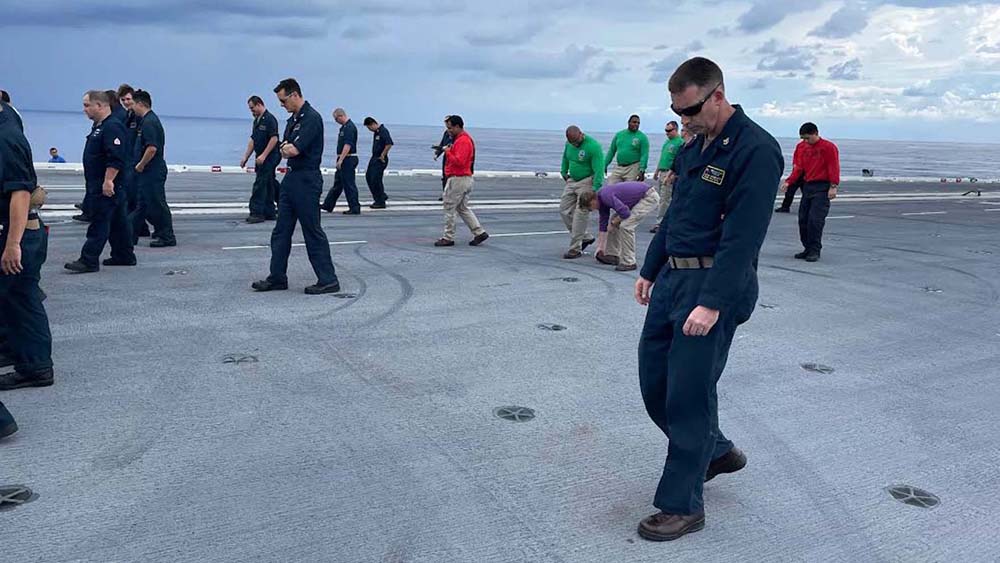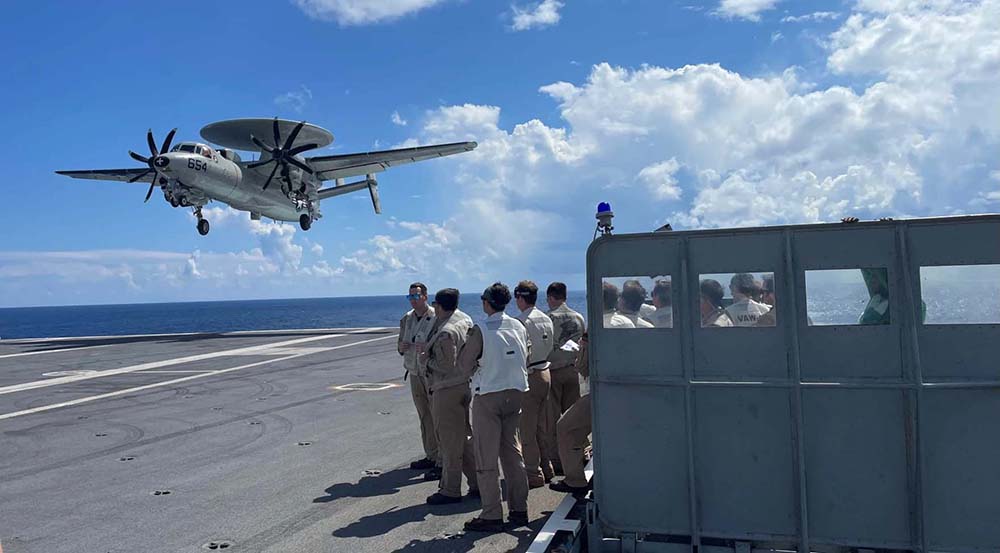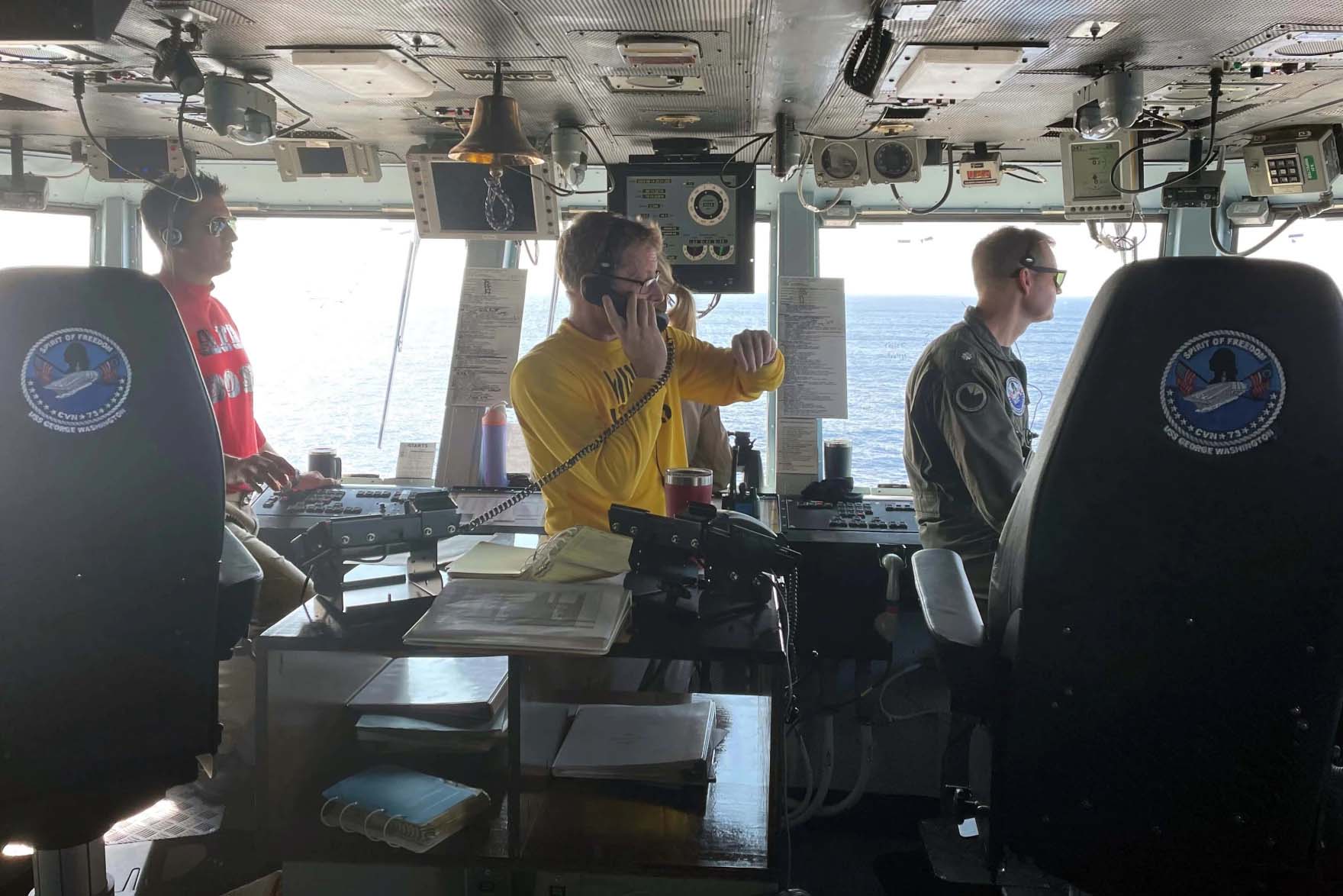From the American Homefront Project:
This story discusses suicide. If you or a loved one needs help, call or text the Suicide and Crisis Lifeline at 988.
Captain William Mathis, the second in command of the USS George Washington, walked the carrier’s flight deck in mid-September.
The ship was operating off the coast of Florida to stay out of the path of Hurricane Lee. Talking with reporters, Lee recalled the feeling on board when a sailor died by suicide January 23.
“The captain cried, I cried, as he was a member of our family,” Mathis said. “It was very difficult. And it will never be easy to deal with the death of one of our sailors, one of our teammates.”
The January suicide was the latest in a series of deaths among Washington crewmembers that coincide with a six-year long maintenance cycle in which the carrier remained in the Newport News shipyard.
The Naval Criminal Investigative Service confirmed that from the time the carrier went into the yard in 2017 to the time it left in May 2023, 11 sailors died by suicide.
“I think we’ve made tremendous changes, but there is no finish line. To lose another sailor, it was difficult. It was gut wrenching,” Mathis said.
The average age of the sailors who died on the Washington was 24. Most had never been to sea. Nine of the 11 died by gunshot wounds to the head. One sailor in 2019 purchased the gun that killed him the day before at the Langley Air Force Main exchange in Hampton, Va. according to reports provided by NCIS.
The crew of USS Washington turned over three times during the six-year-long maintenance cycle. By the time the carrier was ready to return to the fleet, 85% of the crew had never been to sea. Once the ship finally set sail in May, some sailors told Captain Brent Gaut that they thought the carrier would never get underway again.
“You could see a little glimmer of hope in their eyes that for a long time that we hadn’t seen because it had been so long in the shipyard,” Gaut said. “And so to be able to see that, to share that moment with them was so powerful. And we’ve only built upon that since then.”
The Navy’s report on the suicides recommended limiting the time young sailors spend in the yard. Though all nuclear powered carriers and submarines undergo refueling and maintenance halfway through their 50-year lifespan. it can be dreary work.
“George Washington had like 50 sailors driving buses all the time to get back and forth to work,” said John Cordle, a retired captain. “That’s not fulfilling, right?”
The Washington was delayed by the pandemic and by budget cuts, but midlife overhauls always take several years.
The Navy report also recommended delegating the overhauls to experienced ship building crews, rather than leaving the carrier’s crew in the yard for years. But Cordle, who works as a human factors engineer for the safety department at Naval Surface Forces Atlantic in Norfolk, said Navy leaders have pushed back against that idea in the past.
“I’ve watched senior officers bring up the idea for these long avails,” he said. “And then just get crushed.”
Leadership worried about the cost and the loss of control that could result from turning over a ship to another crew, even if they were more qualified to make repairs, Cordle said.

Sailors aboard the USS George Washington walk the deck before flights begin Sept. 15, 2023.
Steve Walsh / American Homefront
Kellylynn Zuni, the ship’s command psychologist, said the number of mental health visits has dropped since the carrier left the yard.
“I think that during the shipyard, we saw an influx of sailors who were just seeking help for shipyard life,” she said. “Things have gotten better.”
The Navy reported sailors on the Washington weren’t being trained on the Navy’s suicide prevention programs. The time to see a mental health provider ballooned to months.
Zuni said the Navy the mental health staff on the carrier is now twice as large. She said the staff is now big enough that they can see anyone who needs immediate help.
She said she’d like to see the extra staff become permanent throughout the fleet.
After three suicides in April 2022, the Navy surveyed the crew and reported a high level of distrust of military medicine and mental healthcare specifically. So the command has given the mental health staff a higher profile.
“I think over time, I’ve seen more sailors saying, ‘Hey, let’s use the resources we have.’ I’m seeing them coming to us more,” said Terrance Levine, the deployed resiliency counselor on the USS Washington.
The Navy is creating 10 new seven-member Special Psychiatric Rapid Intervention Teams (SPRINT) to provide emergency mental health care following traumatic events, such as suicides.
The USS George Washington also is now using a tool borrowed from Naval Aviation that assesses the fitness of pilots. The Navy uses it to assess each sailor on the carrier.
In aviation, green means pilots are safe to fly, red means they’re grounded and need care, while yellow indicates they’re showing signs of stress either in their career or personal life that the command has to monitor, said Command Master Chief Randy Swanson, who joined the Navy in 1996.
“Even though it’s not an issue at work, if there are things going on, we talk about it,” Swanson said. “This is something that never happened back in the day. It was never brought up, unless it was an issue. But now we’re getting ahead of things like, is there a daycare issue with this sailor or a problem with a car? How do we help this sailor out so it doesn’t become an issue?”

E-2 Hawkeye lands on board the USS George Washington, Sept. 15, 2023.
Steve Walsh / American Homefront
The current military mental health system is already straining to meet the demand, as the Navy tries to figure out how to bring down the suicide rate, which is higher than the rate among the general public.
Data provided by the Navy show that it has been able to hire only 66% of the mental health nurse practitioners and train only 40% of drug and alcohol counselors funded in the last federal budget. The service also expects shortages in most mental health specialties as it tries to bring in dozens of new mental health personnel in 2024.
In a statement, the service acknowledged that it faces challenges in recruiting and retaining mental health professionals. It blamed “nation-wide shortages of healthcare providers and long training pipelines.”
Many of the ideas the Navy is considering or implementing aren’t new – like turning over carriers to locally based ship building crews or adding more mental health care providers, but they haven’t been a priority because of cost or other factors.
“A big point is the leadership,” Cordle said. “When you look back over some of the incidents that we’ve had, when you peel back the onion, a lot of the stress was sort of imposed by the leadership either not paying attention, maybe not toxic leadership, but leadership that wasn’t attuned to listen.”
This story was produced by the American Homefront Project, a public media collaboration that reports on American military life and veterans.













